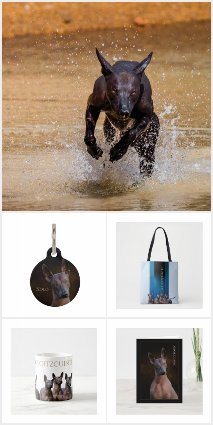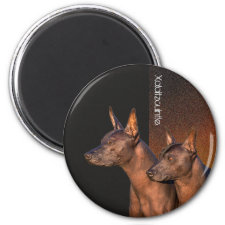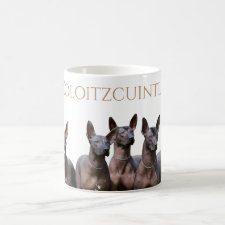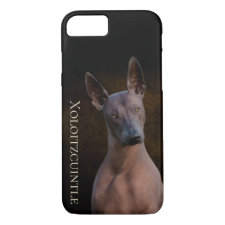History
The Xoloitzcuintle (pronounced Show low eats qweent lee, or Xolo for short) is one of the most ancient breeds in the Western Hemisphere, it is estimated to have originated 3500 years ago in Mexico. Xolos served the Aztecs and Mayans as healers, hunters, guards and bed warmers, as well as a food source and highly significant religious sacrificial token. Due to the delicacy of the meat the Xolo almost became extinct, if not for the Federation Canofila Mexicana (FCM) and a group of extraordinary Xolo saviours in the 1950's the breed possibly would not be here. Early expeditions to remote villages in Mexico gathered pure breeding copies which has become the foundation stock for the modern day Xoloitzcuintle breed.
The FCM has used the Xoloitzcuintle on its logo since 1940, and the Xolo is considered the national treasure of Mexico. In 1956 the FCM initiated a breeding program and registration base for the Mexican Xoloitzcuintle, a breed standard was developed from here. In turn the breed was recognised by The Federacion Canofila International (FCI), the governing body for the majority of kennel clubs worldwide.
The Countess Lascelles de Premio Real was a major contributor to the breed type and the Xolo Standard as it is today. Most Xolos have her dogs in their lines today.
Xoloitzcuintle Breed Characteristics
The gene that produces the absence of hair is dominant, however some Xolos are born with a coat. Xolos often have tusk like canine teeth and sometimes the absence of some teeth.
The Xolo is considered a primitive dog in some behaviours and thought to be much closer to their canine roots than any other breed of dog. The Xolo can make a wonderful pet, however puppies need to be well socialised from the early weeks (just like all dogs.) Xolos are credited with an intelligent and fast learning attitude which will require the owner to earn respect and a utilise a consistent and structured routine.
The Xolo comes in two varieties. The hairless Xolo and the Coated is a very attractive dog characterised by a lack of hair and smooth and soft skin. The Xolo has a well proportioned body, ample chest, ribs well sprung, with long limbs and tail (FCI 234). The coated Xolo is fully coated and with the same harmonious proportions as the hairless variety.
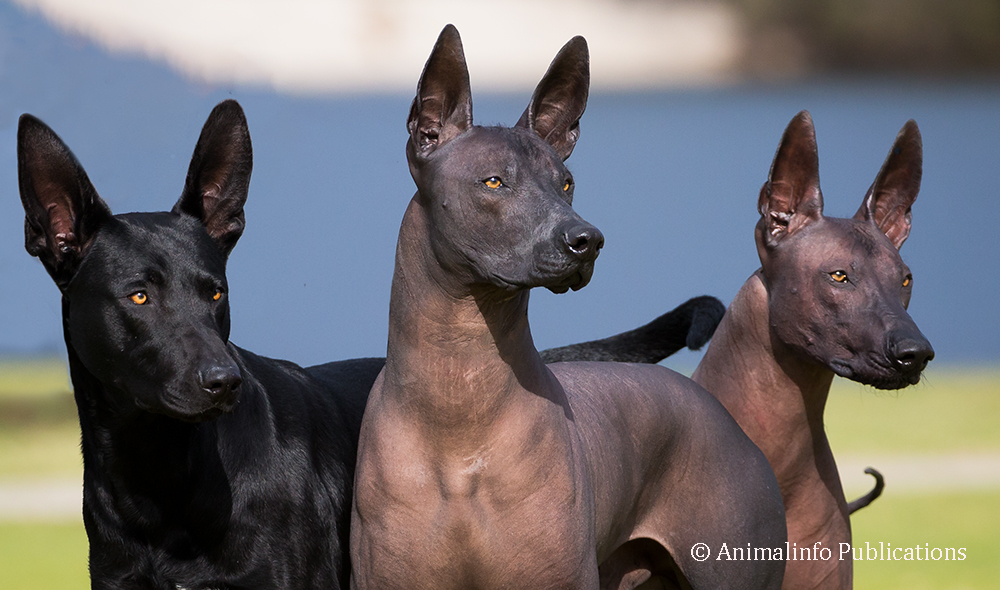
Xolos are in three sizes:
- Miniature 25-35cm
- Intermediate 36-45cm
- Standard 46-60cm (Plus 2cm in top quality dogs)
Whether coated or hairless, Miniature, Intermediate or Standard the Xoloitzcuintle is an intelligent, loyal and extremely devoted companion.
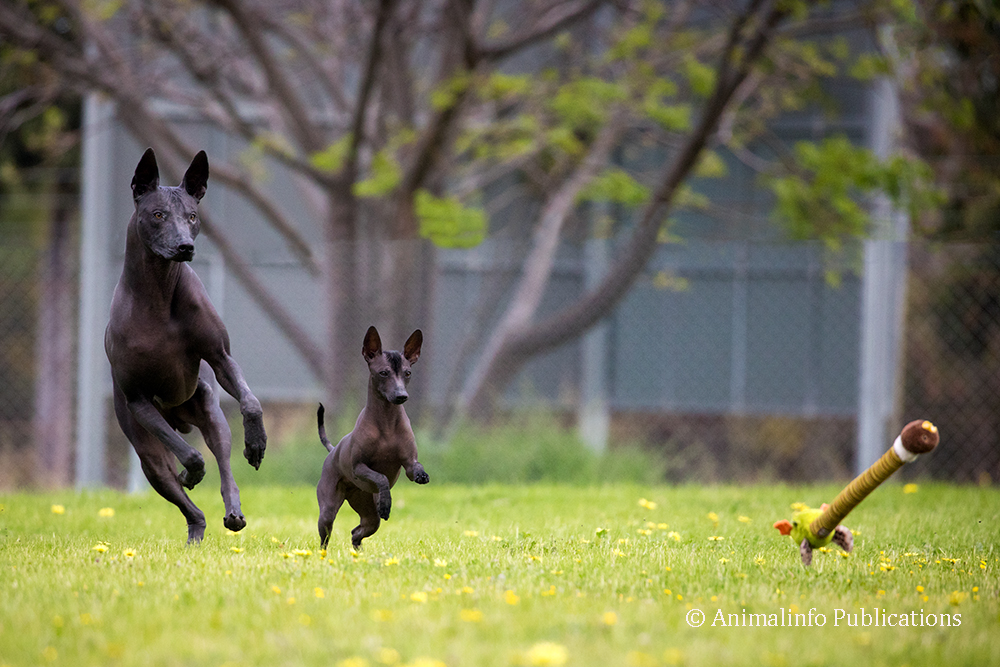
The Xolo is an overall calm dog, cheerful, and alert, yet reserved towards strangers. It is considered not only an excellent companion but a guard dog as well.
Xolo exhibit well in the show ring, obedience and agility arenas, whilst also used worldwide as therapy and assistance dogs.
Care
Xolos enjoy food, and are well known for the liking to chew on veggies and fruit.
During cooler months the Xolo requires a coat, and during summer a sun coat and/or sun protection can be used. Weekly bathing and skin care is advised for the skin to keep in a clean and blemish free state.
The breed was developed from natural selection for thousands of years, rather than alteration of the natural form by man, and they breed does not appear to have any genetic health issues.
They are wonderful dogs but are not for everyone, they require a lot of time and strict routines in the early years and a lot of socialisation, it is advisable for people to have home care or a strict activity plan. Feel free to ask lots of questions and please do lots of research on this breed!
- Xolos were among the very first breeds recorded by the American Kennel Club (AKC) A Mexican dog named Mee Too was the first registered Xolo in 1887. Chinito Junior was the breeds only AKC Champion to date. (October 1940)
- It is estimated approximately 4000 Xoloitzcuintle exist worldwide, it is hard to give a registered figure as not all our registered with a club. This is expected to rise with the USA having full showing of the Xolo from January 2011, the UK is expected to follow soon ( at present they are in the Import Register Class) Australia has had full showing of the Xolo from July 2010.
- Most purebred dogs have been designed for a specific purpose; the Xolo was not. It is unique in the fact that it is a product of natural selection, created and molded by environmental adaptation, rather than selective breeding.
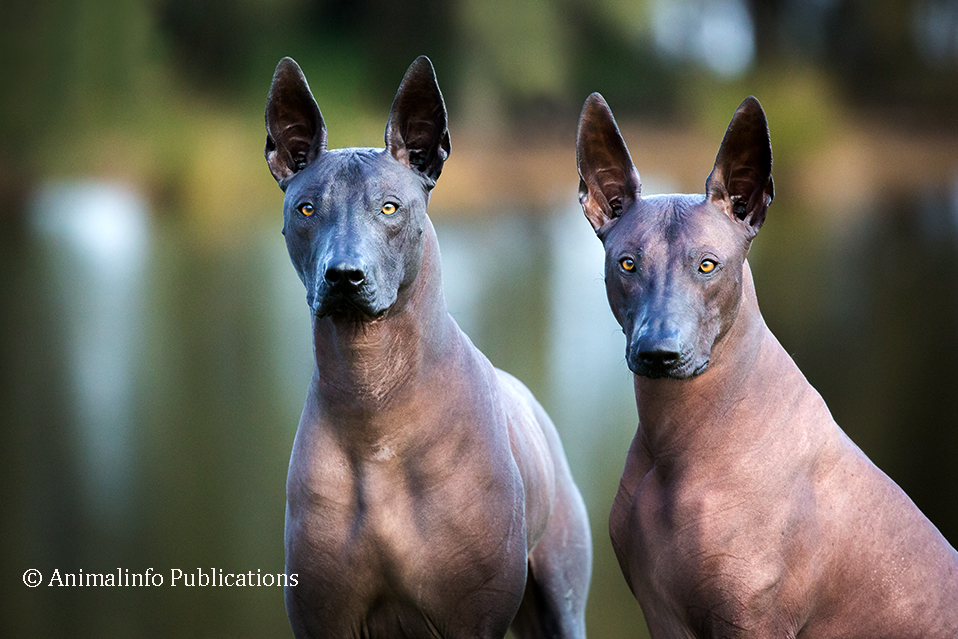
Further information can be found at
www.xoloworld.com
www.xoloaus.com
www.xoloitzcuintliclubamerica.com
The ANKC web site has the Breed Standard and the Breed Standard Extension for the breed.


